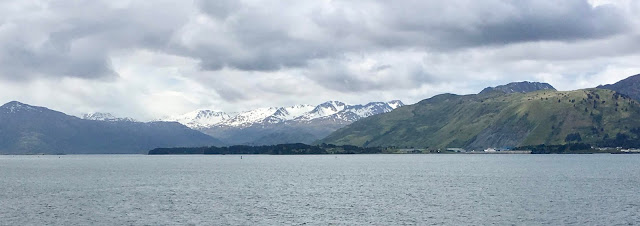The Emperors among us
 |
| The main lab's view of the last seismic reflection data being collected. Overseeing them are drawings of Emperor Jimmu and Empress Suiko. |
 |
| Jeff cheerfully stows seismic "birds" that were removed from the seismic streamer as it was recovered |
The Emperor Seamounts are the oldest volcanoes of the
Hawaii-Emperor Seamount Chain with each seamount named after the oldest
continuing hereditary monarchy in the world, the Emperors of Japan. Jimmu is
the legendary first Emperor of Japan was born in 711 BCE and ruled between 660
to 585 BCE. Jimmu and all the emperors to follow are direct descendants of
Amaterasu, the goddess of the sun in the traditional religion of Japan called
Shinto. Empress Suiko was the first woman to ascend to the Chrysanthemum
Throne, where she reigned from 593 to 628 CE. Outside of the political matters,
she is known for adopting Japan to a Sexagenary cycle calendar, imported from
China which can accurately record time in sixty-year cycles. While we picked
our experiment location solely on geologic interests, these legends of Japan bring
a long cultural history to surface as well. Japan’s rich and well documented
history is too extensive for a single post, much like the long geologic history
of the seamounts we are exploring.
We also arrived to the Emperor Seamount Chain at a unique
time for Japan’s Emperors. Earlier this month Japan had a new enthronement of
Emperor Naruhito after Emperor Emeritus Akihito (the new title of the last
Emperor) reported his abdication to the sun goddess Amaterasu as well as his
ancestors and other deities. The current Emperor Emeritus also visited the
mausoleum of Jimmu in Nara Prefecture back in March to pay his respects before
abdicating. This transition marks a new chapter in the traditional Japanese
calendar moving from the Heisei era (meaning achieving peace) to the Reiwa era
(meaning beautiful harmony). The last Emperor to abdicate was in the early
1800s, marking a rare event for modern Japan. Lastly, the current Emperor
Emeritus, like his father before him, has a passion for the marine sciences,
publishing over 30 papers on goby fish, a small bottom-dwelling near-shore fish
that lives in the Pacific and Sea of Japan. As we continue to finish our
experiment on the Emperor Seamount Chain, we are surrounded by both the geologic
and cultural history of Earth.
Brian Boston
LDEO


Great post, thanks for sharing this article. I am really interested in your blog.
ReplyDeleteseismic equipment
seismic sensor supplier